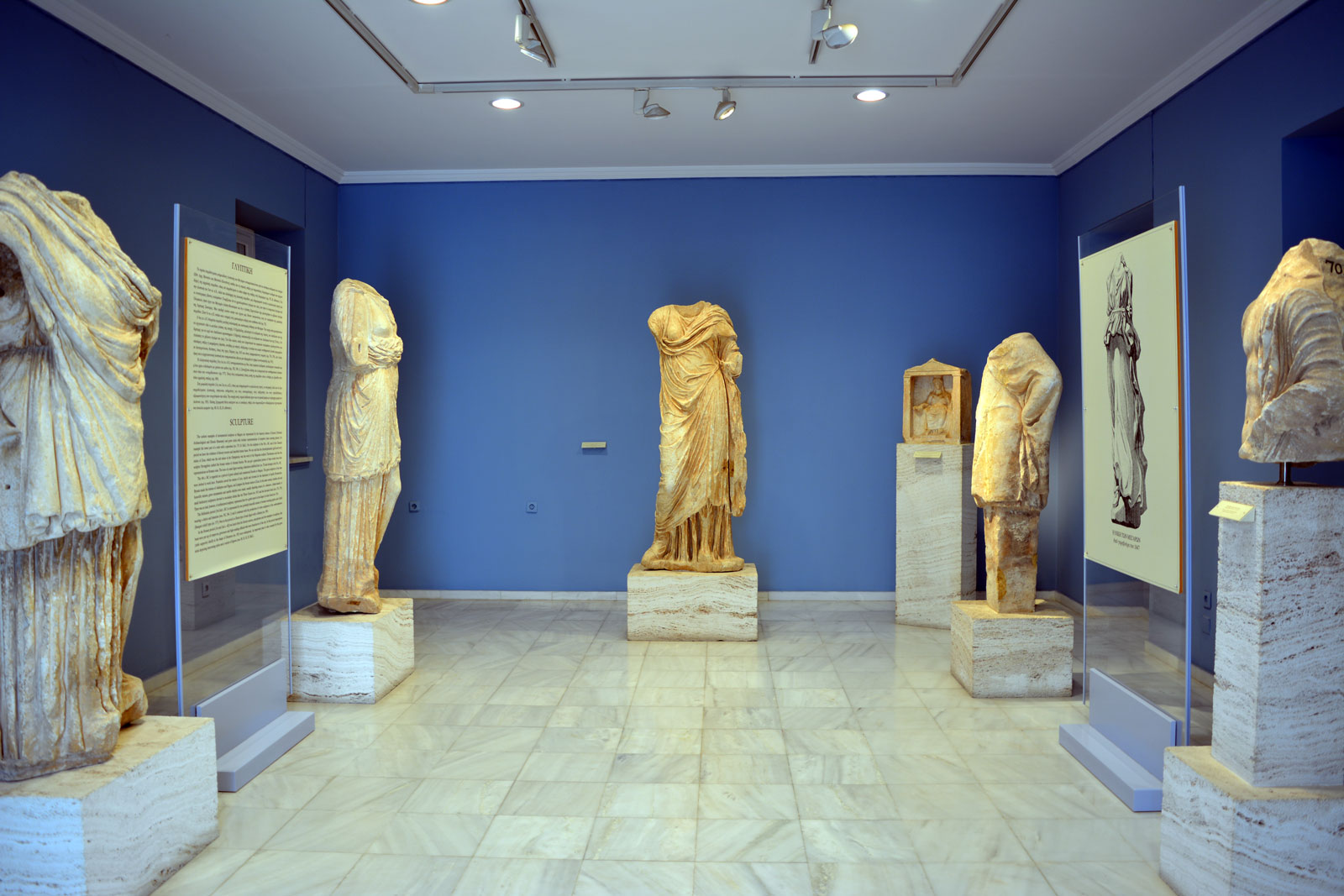
The Archaeological Museum of Eleusis
The museum was designed by J. Mousis, and was built in 1889 in order to house the excavation finds from the site. The westernmost, sixth room is a later addition.Description:Courtyard:Marble sarcophagus of Roman Times (2nd century A.D.) with a scene of the hunting of the Calydonian Boar on the front. Also on display are two sizeable marble torches, some composite capitals from the Lesser Propylaea and some marble funeral vases.
Room I:Protoattic amphora (650 B.C.) with a scene of the blinding of Polyphemos on its neck and the legend of Perseas and Medusa on the body. The ?Fleeing Kore? (early 5th century B.C.), from the decoration of the ?Sacred House?. The decree relief of Rheitoi (421 B.C.).
Room II:Headless statue of the goddess Demeter, original work of the late 5th century B.C., from the workshop of the sculptor Agorakritos. Votive reliefs depicting Triptolemos? mission to spread knowledge of how to cultivate the earth.
Room III:Headless statue of Asklepios, original work of the 4th century B.C. Archaistic statue of a Kore, originally holding a bowl, now lost, containing purification water. Statuette of Poseidon, Roman copy of a work by Lysippos.
Room IV:In the centre of the room are two plaster models depicting the sanctuary in the 6th century B.C. (below) and in the Roman Period(above). Two marble statues of Roman emperors and a statue of Antinoos, a favorite of Hadrian.
Room V:The oversize statue of a cistophorus Kore, in the middle of the room, was one of two Caryatids that supported the roof of the Lesser Propylaea (1st century B.C.).
Room VI:The showcases in this room contain pottery and other small finds from the sanctuary and the cemeteries of ancient Eleusis. All phases of the life of the site are represented, from Prehistoric Times to the late Roman Period. In case 21 there are clay and stone kernoi, characteristic utensils of the Eleusinian cults.
Read more...
Room I:Protoattic amphora (650 B.C.) with a scene of the blinding of Polyphemos on its neck and the legend of Perseas and Medusa on the body. The ?Fleeing Kore? (early 5th century B.C.), from the decoration of the ?Sacred House?. The decree relief of Rheitoi (421 B.C.).
Room II:Headless statue of the goddess Demeter, original work of the late 5th century B.C., from the workshop of the sculptor Agorakritos. Votive reliefs depicting Triptolemos? mission to spread knowledge of how to cultivate the earth.
Room III:Headless statue of Asklepios, original work of the 4th century B.C. Archaistic statue of a Kore, originally holding a bowl, now lost, containing purification water. Statuette of Poseidon, Roman copy of a work by Lysippos.
Room IV:In the centre of the room are two plaster models depicting the sanctuary in the 6th century B.C. (below) and in the Roman Period(above). Two marble statues of Roman emperors and a statue of Antinoos, a favorite of Hadrian.
Room V:The oversize statue of a cistophorus Kore, in the middle of the room, was one of two Caryatids that supported the roof of the Lesser Propylaea (1st century B.C.).
Room VI:The showcases in this room contain pottery and other small finds from the sanctuary and the cemeteries of ancient Eleusis. All phases of the life of the site are represented, from Prehistoric Times to the late Roman Period. In case 21 there are clay and stone kernoi, characteristic utensils of the Eleusinian cults.

The Archaeological Museum of Megara
The Archaeological Museum of Megara presents objects that have come to light from rescue excavations by the ΙΙΙ Ephorate of Prehistoric and Classical Antiquities in the city of Megara and the surrounding region. The finds date from the 8th c. BC to the 2nd c. AD. The exhibition is housed in the Old City Hall, a 19th c. building which the Municipality of Megara has temporarily ceded to the III Ephorate of Prehistoric and Classical Antiquities. The two-storey building has four exhibition halls.
GROUND FLOOR: Marble finds are presented on the building’s ground floor.
GALLERY A: Monumental sculptures and votive reliefs are exhibited in this room, with background information from excavation research and the literary sources on monumental sculpture and reliefs from Megara from the Archaic to the Roman period. There is also a reconstruction drawing of the Nike of Megara, a copy from an 1847 engraving.
GALLERY B: This gallery displays inscriptions containing information about public life, chiefly during the Classical period. It also displays Classical, Hellenistic and Roman funerary stelai, framed by related texts and photos.
FIRST FLOOR: On the first floor finds from the city’s cemeteries and objects of daily use are presented.
GALLERY C: This gallery presents objects selected from grave groups of the 8th to the 1st c. BC. Visual material, photographs, plans and texts related to the place of the ancient cemeteries in the topography of the modern and the ancient city and its burial customs give information related to the exhibit.
GALLERY D: Objects – primarily clay and bronze – connected with daily life in antiquity are displayed in this room. The deposit from an Archaic sanctuary at the site of Bouri in Alepochori is of particular interest; from among its hundreds of finds, representative examples of cult and the local pottery workshop are presented. There is a brief presentation of the excavation, with the assistance of visual material.
COURTYARD AREA: Inscriptions, statue bases, and architectural members from various periods are presented in the courtyard area.
Read more...
GROUND FLOOR: Marble finds are presented on the building’s ground floor.
GALLERY A: Monumental sculptures and votive reliefs are exhibited in this room, with background information from excavation research and the literary sources on monumental sculpture and reliefs from Megara from the Archaic to the Roman period. There is also a reconstruction drawing of the Nike of Megara, a copy from an 1847 engraving.
GALLERY B: This gallery displays inscriptions containing information about public life, chiefly during the Classical period. It also displays Classical, Hellenistic and Roman funerary stelai, framed by related texts and photos.
FIRST FLOOR: On the first floor finds from the city’s cemeteries and objects of daily use are presented.
GALLERY C: This gallery presents objects selected from grave groups of the 8th to the 1st c. BC. Visual material, photographs, plans and texts related to the place of the ancient cemeteries in the topography of the modern and the ancient city and its burial customs give information related to the exhibit.
GALLERY D: Objects – primarily clay and bronze – connected with daily life in antiquity are displayed in this room. The deposit from an Archaic sanctuary at the site of Bouri in Alepochori is of particular interest; from among its hundreds of finds, representative examples of cult and the local pottery workshop are presented. There is a brief presentation of the excavation, with the assistance of visual material.
COURTYARD AREA: Inscriptions, statue bases, and architectural members from various periods are presented in the courtyard area.

